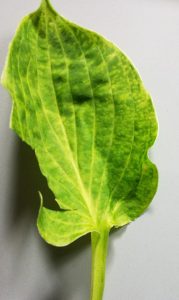Hosta Virus X
Pest Management Fact Sheet #5064
Developed by Alicyn Smart, Assistant Extension Professor & Extension Plant Pathologist, University of Maine Cooperative Extension, and Nathan Andrews.
For information about UMaine Extension programs and resources, visit extension.umaine.edu.
Find more of our publications and books at extension.umaine.edu/publications/.
Introduction

Hosta virus X (HVX) is the most common viral disease to infect hostas in Maine. When this virus was first discovered in the mid-1990’s, it was encouraged to spread, as it created a very unique look to the plants it infected. Varieties such as “Leopard Frog,” “Blue Freckles,” and “Lunacy” became very popular for their interesting leaf patterns and colors. HVX is a virus in the group known as “potexviruses,” including viruses such as potato virus X. These viruses spread primarily through transfer of plant sap. This most commonly occurs through gardening, specifically when infected plant sap gets on tools that are used on uninfected plants. Insect feeding from insects such as thrips (Thysonoptera), beetles (Coleoptera) or caterpillars (Lepidoptera) can cause sap to spread via mandibles from infected to uninfected plants.
Host Plants
Hostas (Hosta sp/spp.)
- All varieties and cultivars are susceptible, with golden hosta varieties such as “Gold Standard”, “Golden Tiara” and “Regal Splendor” being especially susceptible
Symptoms and Signs
Not all hostas will show initial symptoms of HVX. It is also possible that some cultivars will not show any symptoms until the second year of growth post-infection. The most common symptoms of this disease are a bleeding of color out from the veins of the leaves and blue or dark green mottling on the leaves (Figure 1). HVX can also cause distortion in the leaves such as puckering and twisting as well as ring spots, flecks and zipper marks. Infected plants will also have more stunted growth than that of healthy plants. Occasionally, the leaves will develop necrotic lesions. Varieties that are highly susceptible will shed the infected leaves, culminating in the death of the plant.
Management
- Carefully inspect any plants for color bleeding and leaf mottling before purchasing.
- Before planting new plants, isolate from any other hostas for about 1 week to see if any symptoms develop.
- Remove any and all plants that exhibit symptoms and either burn them or throw them away in their own trash bags. Do not compost.
- Wash all tools and hands with soap and water for at least one minute before and after working with the plants. Normal sterilization with 70% rubbing alcohol will not be effective for HVX management.
References
Arcibal, Eric (January 13, 2015). Hosta Virus X. Retrieved from Wisconsin Horticulture – Division of UW Extension: https://hort.extension.wisc.edu/articles/hosta-virus-x/
Smith, Sherrie, Gergerich, Rose and Jim Robbins. Hosta Virus X. Retrieved from the University of Arkansas – Division of Agriculture Extension:https://www.uaex.edu/publications/pdf/FSA-7548.pdf
WHEN USING PESTICIDES, ALWAYS FOLLOW LABEL DIRECTIONS!
Alicyn Smart, DPM
Plant Pathologist and Director of the Plant Disease Diagnostic Laboratory
University of Maine Cooperative Extension
Information in this publication is provided purely for educational purposes. No responsibility is assumed for any problems associated with the use of products or services mentioned. No endorsement of products or companies is intended, nor is criticism of unnamed products or companies implied.
© 2019
Call 800.287.0274 (in Maine), or 207.581.3188, for information on publications and program offerings from University of Maine Cooperative Extension, or visit extension.umaine.edu.
The University of Maine is an EEO/AA employer, and does not discriminate on the grounds of race, color, religion, sex, sexual orientation, transgender status, gender expression, national origin, citizenship status, age, disability, genetic information or veteran’s status in employment, education, and all other programs and activities. The following person has been designated to handle inquiries regarding non-discrimination policies: Director of Equal Opportunity, 101 North Stevens Hall, University of Maine, Orono, ME 04469-5754, 207.581.1226, TTY 711 (Maine Relay System).

